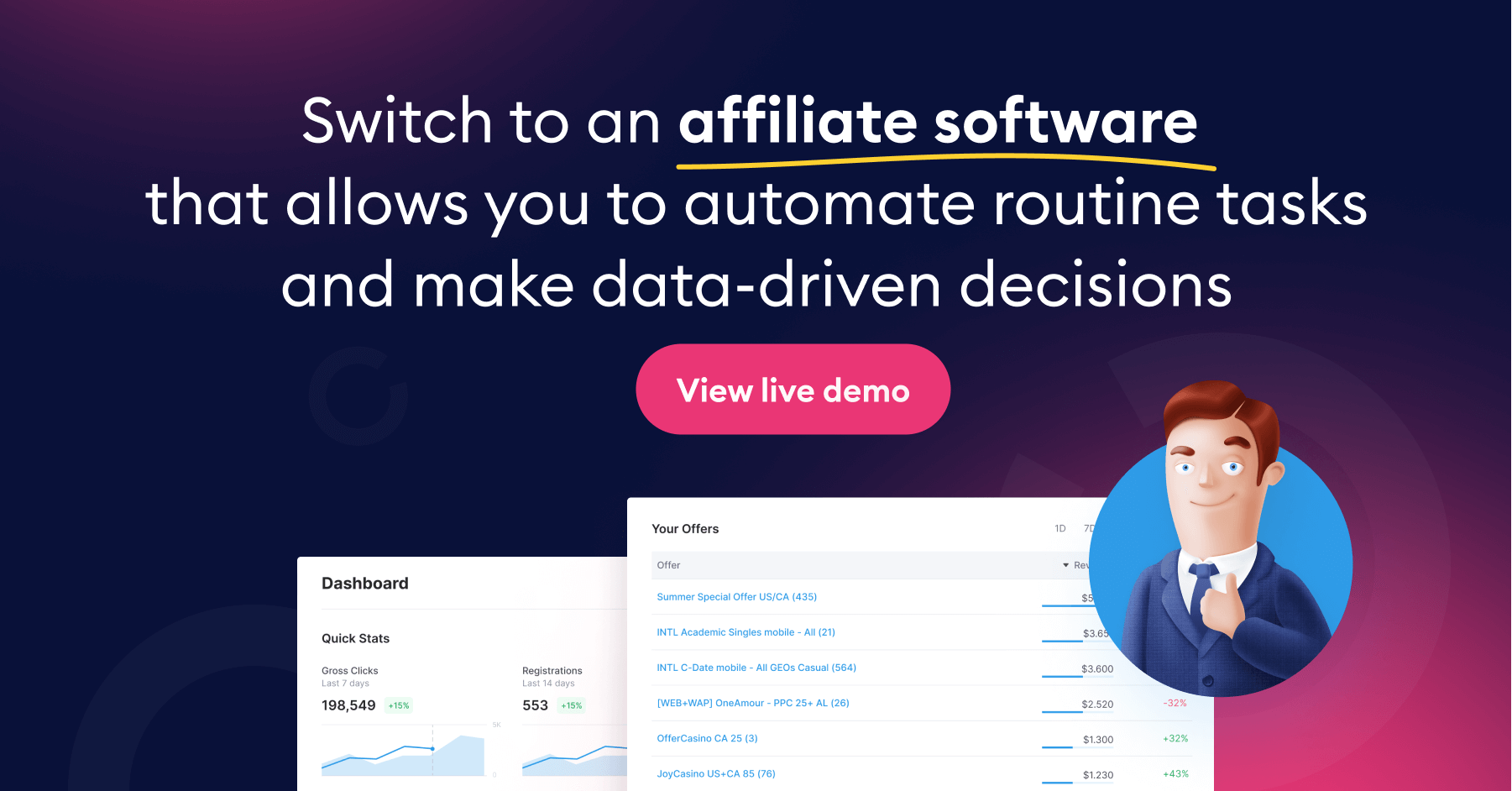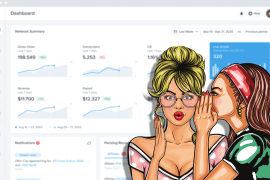OpenAI tools for partner marketing have been taking the internet by storm lately. If you are in the partner business, you are probably already overwhelmed by its’ growing popularity but may not know exactly how your business can benefit from it.
As you already know, partner marketing is a business model where you earn a commission for promoting other people’s products. It may seem like a great way to create a nearly passive income business, but in reality, it requires a lot of work, including:
- finding and promoting products
- building a website or social media presence
- driving traffic to your partner links
One tool that can help you streamline and automate some of these tasks is OpenAI. This cutting-edge artificial intelligence platform offers a range of powerful tools and services for businesses. In this post, we’ll explore how you can use OpenAI to boost your partner marketing efforts, including:
- generating content
- writing sales ad copy
- analyzing data
- optimizing campaigns
So if you’re ready to take your partner marketing to the next level, keep reading!
What is OpenAI?
OpenAI is a non-profit research organization that promotes and develops friendly artificial intelligence—founded in 2015 by a group of high-profile entrepreneurs and researchers, including Elon Musk and Sam Altman, with the explicit goal of advancing the field of AI while also ensuring that it is ethical and beneficial to humans.
OpenAI conducts AI research in various areas, including machine learning, robotics, and economics, and has made many significant contributions to the field. The organization is also known for developing and releasing several powerful AI tools and platforms, such as:
- GPT (Generative Pre-trained Transformer), a natural language processing model capable of producing human-like text,
- DALL-E is a system capable of producing original artwork from textual descriptions.
These and other OpenAI tools are widely used in industry, academia, and the AI community at large.
What is OpenAI capable of?
Artificial intelligence has developed a range of powerful tools and platforms that researchers, businesses, and individuals widely used.
Some of the key capabilities of artificial intelligence and OpenAI, in particular, include:
- Natural language processing: OpenAI has developed a number of advanced natural language processing (NLP) models, including GPT, which can generate human-like text and understand and respond to natural language input. These models have been used for translation, summarization, and language generation tasks.
- Machine learning: OpenAI has research teams focused on various machine learning (ML) areas, including deep learning, reinforcement learning, and unsupervised learning. It has developed several influential ML models and frameworks, including DQN, the first deep reinforcement learning algorithm to achieve superhuman performance on Atari games.
- Robotics: OpenAI has also conducted research in the field of robotics and has developed many platforms and tools for robotics applications, including the OpenAI Gym, a toolkit for developing and comparing learning algorithms, and RoboSumo, a platform for training and evaluating robotic policies.
- Economics: OpenAI has also applied its AI expertise to economics and developed tools such as AI-powered market simulations and predictive models for economic forecasting.
As you can see, OpenAI is known for its expertise in a wide range of AI-related fields and for developing innovative and influential tools and platforms that are widely used in industry and academia.
3 Ways To Use OpenAI in a Partner Marketing Business
There are several ways that OpenAI can be used to support and enhance a partner marketing business. Some potential applications include:
Generating content
OpenAI’s natural language processing (NLP) models, such as GPT, can generate high-quality, engaging content for a partner marketing website or social media account. For example, a partner marketer could use GPT to generate product descriptions, blog posts, or social media posts that promote their partner products.
Here are a few ways that OpenAI can be used for content generation and generating ad sales copy:
- Product Descriptions: OpenAI’s NLP models can generate detailed and accurate product descriptions for a partner marketing website. These descriptions can highlight the features and benefits of the products and persuade potential customers to purchase.
- Blog Posts: OpenAI’s NLP models can also generate informative and engaging blog posts for a partner marketing website. These posts can provide valuable information about the products, share user reviews, or offer tips and advice related to the products.
- Social Media Posts: OpenAI’s NLP model can generate social media posts that promote partner products and drive traffic to a partner’s website. These posts can be used on platforms such as Twitter, Facebook, and Instagram to reach a wider audience and increase sales.
- Ad Sales Copy: OpenAI’s NLP models can also generate ad copies for partner marketing campaigns. These ads can promote products and drive traffic to a partner’s website. OpenAI’s models can generate ad copy that is persuasive, relevant, and targeted to the right audience.
Analyzing data
OpenAI’s machine learning (ML) capabilities can analyze large amounts of data and identify trends and patterns that can inform a partner’s marketing strategy. For example, a partner marketer could use ML to analyze customer reviews, website traffic data, or social media engagement to identify the most popular or effective products or promotional techniques.
OpenAI’s capabilities can be utilized to analyze data from a partner marketing campaign and identify trends and patterns that can inform strategy.
Here are a few examples:
- Customer reviews: OpenAI’s ML models can be used to analyze customer reviews of partner products to identify trends and patterns in customer sentiment. This can help a partner marketer understand what customers like or dislike about a product and adjust their marketing strategy accordingly.
- Website traffic data: OpenAI’s ML models can also be used to analyze website traffic data to identify patterns and trends in how users interact with a partner marketing website. For example, a partner marketer could use ML to identify the most popular pages or products on their website and optimize their marketing efforts accordingly.
- Social media engagement: OpenAI’s ML models can be used to analyze social media engagement data to identify trends and patterns in how users interact with a partner marketing business on social media platforms. This can help a partner marketer understand what types of content or promotions are most effective at driving engagement and sales.
- Sales data: OpenAI’s ML models can be used to analyze sales data to identify trends and patterns in how customers interact with partner products. This can help a partner marketer understand what products are most popular and how they can optimize their marketing efforts to drive more sales.
Optimizing and Automating Campaigns
OpenAI’s tools and platforms can also optimize and automate partner marketing campaigns. For example, a partner marketer could use reinforcement learning to optimize email marketing campaigns or robotic automation to streamline product research or link building tasks.
Here are a few ways how you can use OpenAI to optimize your campaigns:
- Email marketing: OpenAI’s reinforcement learning algorithms can optimize email marketing campaigns by identifying the most effective subject lines, content, and send times for different segments of an email list.
- Paid advertising: OpenAI’s ML models can be used to optimize paid advertising campaigns by analyzing data such as click-through rates, conversion rates, and customer demographics to identify the most effective ad copy, targeting, and budget allocation.
- Social media: OpenAI’s NLP models can be used to generate social media posts that are optimized for engagement and conversions. These models can analyze data such as likes, comments, and shares to identify the content and messaging most effective at driving traffic and sales.
- SEO: OpenAI’s ML models can optimize a partner marketing website for search engines by analyzing keyword search volume and website traffic data to identify the most effective keywords and content for driving traffic and sales.
- Link building: OpenAI’s robotic automation tools can streamline building high-quality links to a partner marketing website. These tools can automate tasks such as identifying potential link opportunities, reaching out to website owners, and tracking the success of link-building efforts.
- Product research: OpenAI’s NLP models can automate the process of researching and identifying new partner products to promote. These models can analyze large amounts of product data and identify products that are likely to be popular and successful based on factors such as customer reviews, sales data, and market trends.
- Customer service: OpenAI’s chatbot can automate customer service tasks such as answering common questions, handling customer complaints, and directing customers to the right resources. This will free up the partner marketer’s time to focus on other tasks.
- Customer segmentation: OpenAI’s ML models can segment a partner marketing business’s customer base into different groups based on demographics, interests, and behavior. This can help partner marketers tailor their marketing efforts to different customer segments and optimize their campaigns for better results.
- Personalization: OpenAI’s NLP models can be used to personalize marketing messages and content for different customer segments. These models can analyze customer data and generate personalized emails, social media posts, and website content tailored to each customer’s interests and needs.
Downsides of using OpenAI in Partner Marketing Business
While OpenAI’s tools and platforms can provide a range of benefits for a partner marketing business, it’s important to carefully consider the potential downsides before using them. There are a few potential downsides to using OpenAI in a partner marketing business:
- Cost: Some of OpenAI’s tools and platforms may require a subscription fee or may be charged for usage. This can be a high cost for small businesses or individuals starting out in partner marketing.
- Learning curve: OpenAI can be complex and may require a learning curve to be used effectively. This can be a challenge for partner marketers who are new to AI or who don’t have a technical background.
- Dependence on technology: Using OpenAI to automate tasks in a partner marketing business can make the business more dependent on technology. The technology could disrupt the business’s operations if something goes wrong.
- Limited capabilities: OpenAI’s tools may not be able to handle all aspects of a partner marketing business. For example, they may not be able to fully replace the creativity and personal touch that a human brings to content creation or customer service.
Conclusion
Using OpenAI’s tools and platforms in a partner marketing business can bring many benefits, including automation, data analysis, and automated content generation. These tools can help partner marketers save time, improve their campaigns, and drive better results.
However, it’s also essential to carefully consider challenges and to choose the right tools and platforms based on the needs and resources of the business.
Using OpenAI can provide a range of benefits for a partner marketing business. Still, it’s important to carefully consider the potential challenges and implement them in a practical and sustainable way for the business.
Looking for a way to automate your partner marketing business? Try Scaleo, where you can filter fraud traffic and analyze campaigns in real-time.

Last Updated on January 2, 2024






![10 Ways To Automate Affiliate Marketing Business [2024 Update] 10 Ways To Automate Affiliate Marketing Business [2024 Update] - openai in partner marketing](https://www.scaleo.io/blog/wp-content/uploads/2023/03/automate-affiliate-marketing-software-program-270x180.jpg)
